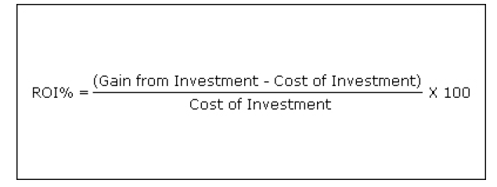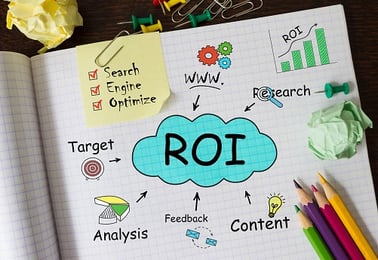
Traditionally, return on investment (ROI) is a simple calculation of financial gain minus its cost divided by the cost. It is expressed in a percentage and, the larger the number, the better.

In marketing, the calculation is not that simple. There are many, many factors that contribute to revenue generation, but not all of them are exclusive to a single product line, service group, or campaign. Calculating marketing ROI can become an educated guess, which most financial gurus would find quite disturbing.
How is Marketing ROI Used?
While it is difficult to certify a precise calculation of marketing return on investment, it is a very important measurement. Many future decisions will be made after reflecting on these results. For example:
- Top leaders will evaluate the marketing team based on the successes and shortfalls of their marketing campaigns.
- Production forecasts may be linked to the company’s proven ability to move product with support from marketing and sales.
- Revenue forecasts for product lines and service groups will be made with consideration for the marketing investment required.
- When developing future campaign strategies, the marketing team will reflect upon the results produced by individual tactics and strategies.
Marketing ROI is not only important to big picture planning, but also to day-to-day conversations within the marketing department. All brainstorming sessions, drafting of campaign strategies, and the selection, execution, and A/B testing of individual tactics will be guided by the results you were able to produce last time around.
The Challenge

Calculating the ROI of a widget that costs $5 to produce and sells for $20 retail is simple. Unfortunately, calculating the cost of marketing this widget is not as easy. Why? There are many factors that impact marketing ROI. Let’s take a look.
- Each touch has value – The average customer is exposed to a brand 7-10 times before buying. How much of the cost of producing the PPC ads, ebook, blogs, social media posts, and a video that preceded the purchase decision should be weighed against the sale?
- These things take time – There may be a week, a month, or several months between the first time a prospect learns about your product or service and the day they become a customer. If your marketing ROI is calculated monthly, quarterly, or annually, how can we factor in the cost of ongoing lead nurturing?
- Appraising brand loyalty – One of the benefits of effective marketing is cultivating brand awareness and loyalty. If a customer purchases a product or service from a well-loved brand, how can we accurately quantify the influence of brand awareness to include it in the calculation of marketing ROI?
These are just a few of the sticky situations we deal with every day when trying to justify marketing investments and measure success. Accurately tracking each touch and quantifying each influence is a challenge, no doubt about it. We have found that the key to preserving your sanity is to document the decisions you make during the process and repeat those steps exactly each time so that every future comparison will represent an equivalent.
Calculating Marketing ROI
Presenting an accurate marketing ROI requires clarity. You need to determine which expenditures will be included in your cost calculation and assign
In her interview with the Harvard Business Review, Jill Avery, senior lecturer at Harvard Business School and coauthor of HBR’s Go To Market Tools, recommends establishing a sales baseline that represents what your sales and profit would have been without marketing. While she admits it is challenging, she asserts that this method will provide the most accurate marketing ROI.
Maximizing Your Results
Unlike traditional marketing methods, inbound marketing enables you to track everything from an email that was previewed in Outlook and then deleted to exactly which images and text a visitor looked at on your website. There are many ways we can use this data to maximize the effectiveness of our marketing, and thereby increase marketing ROI. For example:
- Implement
Smarketing – By combining the strategic insights of your sales and marketing teams, you can reduce your sales cycle and increase your overall effectiveness. - Automate Everything – Implementing
a fully automated sales and marketing platform, you can see the effectiveness of individual tactics, campaigns, and strategies in a glance on one dashboard. - Tweak Your Assets – Continually running A/B tests provides hard data about what is working, and works better. User experience data is invaluable.
- Tap Influencer Networks – Collaborating with influencers helps amplify the exposure of your brand through third-party validation to your target market from a trusted source.
- Establish an ROI goal – Setting a minimum standard for marketing ROI will help you make decisions about where to invest your marketing budget.
As with most things in life, quality trumps quantity when measuring marketing ROI. We understand that this is no small feat. We have a team of experts who thrive on providing solutions to complicated marketing challenges. We would be glad to help you measure and maximize your marketing ROI, or assist you with any other marketing challenges you may be facing.
